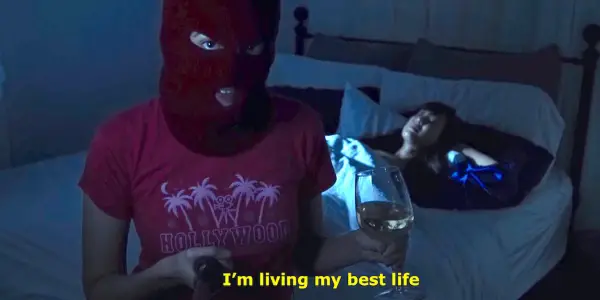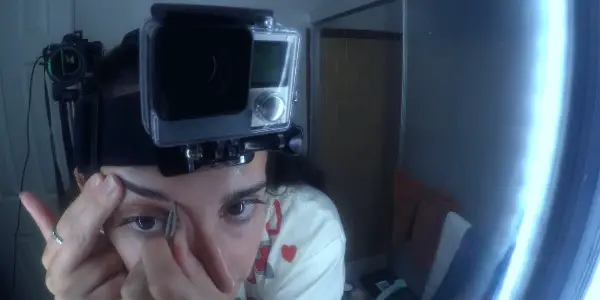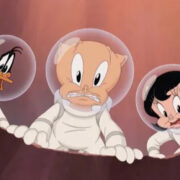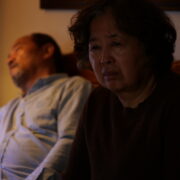Indie Memphis Film Festival 2020: I BLAME SOCIETY

Stephanie Archer is 39 year old film fanatic living in…
Have you ever thought about how you would commit the perfect murder? Hashed out the mechanisms of execution and the evasion of being caught? It seems like it is a conversation we have all had with others or ourselves at some point. How would you do it? And could you get away with it? This is the question I Blame Society tackles, taking the process of thought one step further.
I Blame Society, from writer and director Gillian Wallace Horvat, is one of the most awkward, quirky and original horror films I have seen in a while, and definitely one of the best films of the year. Its originality in storytelling and content takes the dark sides of self, and fans it over the flame, always threatening to go over the edge and speaking to potentially the darkest recesses of our mind. This is is a feature debut from director Wallace Horvat, and based on this film alone, sign me up for more.
The Compliment
I Blame Society begins with a young filmmaker, Gillian (Gillian Wallace Horvat), on-screen, as she begins to draw the audience in, explaining the premise of her film. Though it is not the audience she is necessarily telling it to (we are the film’s onlookers), rather it is to the gentleman in front of her – her friend whose name has been changed to eliminate culpability and to protect his identity. As she asks him to recall, she was recently complimented by her friends who believed that she would make a good serial killer. Without flinching or delay, he agrees with a soft laugh.

As she continues to explain, the compliment got her to thinking – could she actually commit a murder and who would she kill? As she explains, it would need to be a person who has wronged someone she loves – in this case, his girlfriend. Clearly horrified, their interaction ends, the project quickly shelved as the young filmmaker turns her attention to other projects. Three years later, and still a struggling filmmaker, she finds herself unable to avoid this piece of cinema she had been so driven to create in the first place.
Creating a killer
The concept of I Blame Society in itself is original and fresh. Gillian starts off awkward and unsure, just as you would imagine it being if this entire scenario had been real. Yet, while the originality of the film will garner your attention, it is the entire narrative and unfolding of a killer that truly makes this film a successful hit. As she returns to her project, resolved to finish it, she is more concise in her execution this time. She does not bare her soul and reveal her plans to anyone other than the camera – and consequently the audience. We are a privileged group to witness the creation of villainy.

As Gillian begins to descend into her documentary (similar to the film itself), she makes conscious decisions to follow the small acts that accelerate and fine-tune a killer’s MO. Starting off with a simple shoplifting incident and learning to make handcuff knots, she quickly moves on to stalking, breaking and entering, and so on. All the while she is not only forming her MO and sorting out the best means to accomplish each step but also begins attributing excuses for why it is okay to do what she is doing. “It’s for the film”, “It’s not like I am going to put it on the internet.” She begins to rationalize her behavior giving herself permission to peruse further.
Women in Horror
While Gillian is descending into murder, blurring the lines between her art and violence, the film itself delivers its own messages regarding art and the role of women. Gillian is consistently attempting to have one of the scripts produced and to find her breakthrough directing opportunity. Yet, she is consistently turned down. Many times she is too dark, decision-makers liking her shorts but referring to them as “super f*cked up” – these comments accompanied by remarks on how she seems like such a nice girl.
There is still the resounding stereotype of what women in Hollywood should create and the the like-ability of those characters they bring to screen. Women are not welcomed as the future Eli Roth’s, James Wan’s or Leigh Whannell‘s, instead expected to produce happiness and simple scares – nothing deep, dark or gory. Hollywood is unable to find a spot within their productions, rarely attempting to carve them a place, where films such as the one Gillian’s makes can exist. Never mind writing female characters in any way other than like-able leads.

Wallace Horvat challenges this perspective with her film I Blame Society. She calls to this behavior and view point, stating the struggles women still face. She also calls this out as Gillian in the film speaks to the danger her character is facing of becoming unlikeable and allowing the film, in general, to take her to dark places. It is here I Blame Society is not only original, but it is also relevant, calling for a continued change for our treatment of women in the industry – both in front of the camera and behind.
Let’s Get Technical
The handheld camera structure to the film gives I Blame Society more of an authentic and realistic feel to the film. It is not concerned with cinematography or lighting, and framing is at times erratic and constantly changing – which only further heightens the film’s success. All of this culminated further creates a freedom for both the filmmaking style and the character herself – there are no self-perceived boxes that can restrain the directions of the film and its subject.
Wallace Horvat delivers a strong script for her characters, authenticity in reaction, and engaging in what could possibly happen next. You linger on Gillian’s words, waiting to see how far she will take this. And Wallace Horvat’s performance as the awkward and quirky filmmaker only drives the dialogue home. She is determined to make this film happen both as a filmmaker, on-screen, and behind the camera, and it resonates throughout every element of the film.
Where the film brilliantly excels is in its precise editing. Wallace Horvat uses an array of cameras, each angle and perspective elevating I Blame Society further, giving not only close-ups but wide shots to encompass an entire situation. We are not limited to the perspective of the fictional filmmaker, expanding on the story Wallace Horvat has set out to tell.
Conclusion: I Blame Society
I can not recommend I Blame Society enough. Thus far at the festival, this is my favorite film I have screened – and one of my favorites of the year. The originality of story and filmmaking is a sight to see, and its narrative is an exquisite example of how quickly the thin line between reality and art can blur. It is also a showcase of the preconceived notions of women in the film industry that we still need to shed. If you have the opportunity to see I Blame Society, please do. You will not regret it.
I Blame Society had its premiere at the Indie Memphis Film Festival on October 24th.
Watch I Blame Society
Does content like this matter to you?
Become a Member and support film journalism. Unlock access to all of Film Inquiry`s great articles. Join a community of like-minded readers who are passionate about cinema - get access to our private members Network, give back to independent filmmakers, and more.













